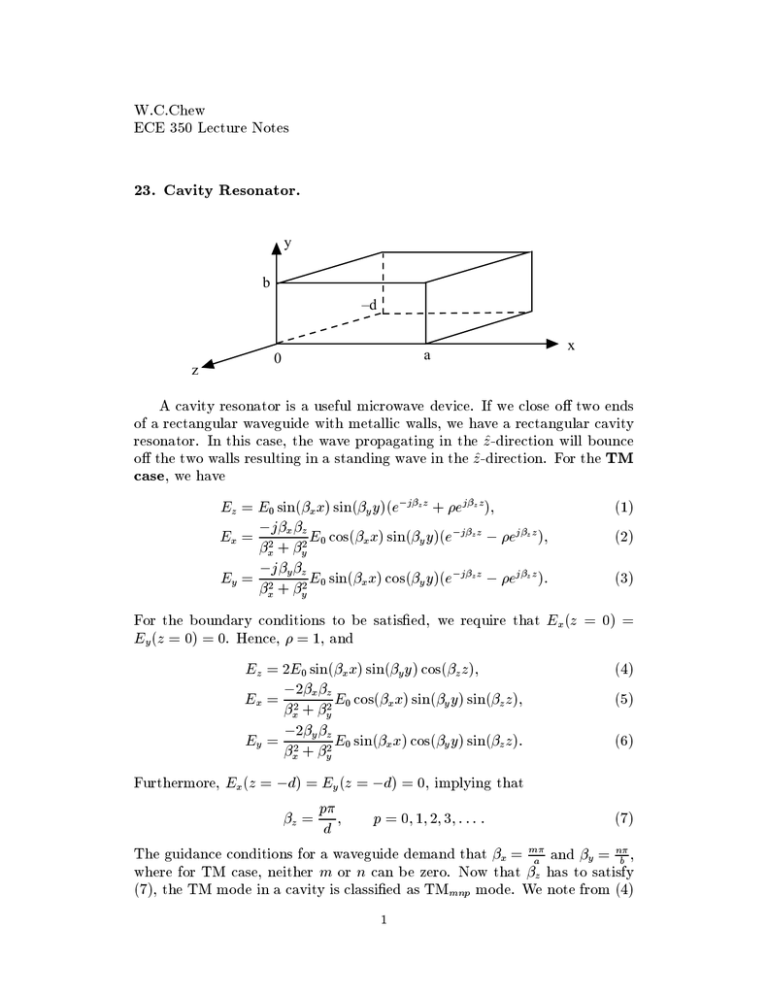23. Cavity Resonator.
advertisement

W.C.Chew ECE 350 Lecture Notes 23. Cavity Resonator. y b –d z a 0 x A cavity resonator is a useful microwave device. If we close o two ends of a rectangular waveguide with metallic walls, we have a rectangular cavity resonator. In this case, the wave propagating in the z^-direction will bounce o the two walls resulting in a standing wave in the z^-direction. For the TM case, we have Ez = E0 sin(xx) sin(y y)(e;jzz + ejz z ) (1) ; j (2) Ex = 2 +xz2 E0 cos(xx) sin(y y)(e;jzz ; ejz z ) x y Ey = ;2j+y z2 E0 sin(xx) cos(y y)(e;jzz ; ejz z ): (3) x y For the boundary conditions to be satised, we require that Ex(z = 0) = Ey (z = 0) = 0. Hence, = 1, and Ez = 2E0 sin(xx) sin(y y) cos(z z) (4) xz E cos( x) sin( y) sin( z) Ex = ;22+ (5) x y z 2 0 x y Ey = ;22+yz2 E0 sin(xx) cos(y y) sin(z z): (6) x y Furthermore, Ex(z = ;d) = Ey (z = ;d) = 0, implying that (7) z = p d p = 0 1 2 3 : : : : The guidance conditions for a waveguide demand that x = ma and y = nb , where for TM case, neither m or n can be zero. Now that z has to satisfy (7), the TM mode in a cavity is classied as TMmnp mode. We note from (4) 1 that p can be zero while Ez 6= 0. Hence, the TMmn0 cavity mode can exist. In order for (4), (5), and (6) to be solutions to the wave equation, we require that 2 2 2 n p m 2 2 2 2 ! = x + y + z = a + b + d : (8) For a given choice of m, n, and p, only a single frequency can satisfy (8). This frequency is the resonant frequency of the cavity. It is only at this frequency that the cavity can sustain a free oscillation. At other frequencies, the elds interfere destructively and the free oscillation is not sustained. From (8), we gather that the resonant frequency for the TMmnp mode is 1 2 n 2 + p 2 2 : !mnp = p1 m + a b d For the TE case, similar derivation shows that Hz = H0 cos(xx) cos(y y) sin(z z) y H cos(xx) sin(y y) sin(z z) Ex = j! 2 + 2 0 x (9) (10) (11) y x H sin(xx) cos(y y) sin(z z): Ey = ; j! 2 + 2 0 x y Similarly, the boundary conditions require that n = p : x = m y= a b z d (12) (13) When p = 0, Hz = 0, hence TEmn0 mode does not exist. However, TE0np or TEm0p modes can exist. The resonant frequency formula is as given in (9). If a > b > d, the lowest resonant frequency is the TM110 mode. In this case, 1 2 2 2 !110 = p1 a + b (14) and Ez 6= 0, Hx 6= 0, Hy 6= 0, Ex = Ey = 0. A sketch of the eld is as shown. y b — H-field E-field TM110 mode z a x We can decompose the wave into plane waves bouncing o the four walls of the cavity. 2 y b 0 a x As an example, for a = 2 cm, b = 1 cm, d = 0:5 cm, the resonant frequency of the TM110 mode is s 52 = 3 108 p5Hz 2f110 = 3 108 4(10 ;2 )2 2 10;2 or (15) p (16) f110 = 43 1010 5Hz = 1:68 1010 Hz = 16:8GHz: Cavity resonators are useful as lters and tuners in microwave circuits, as LC resonators are in RF circuits. Cavity resonators can also be used to measure the frequency of an electromagnetic signal. 3




